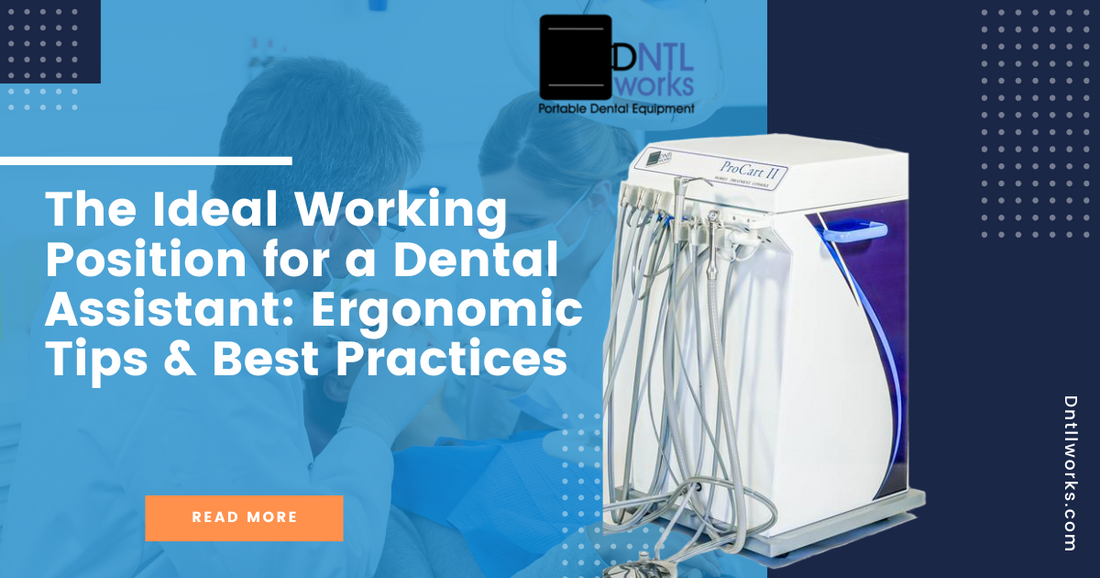
The Ideal Working Position for a Dental Assistant: Ergonomic Tips & Best Practices
Share
The role of a dental assistant requires precision, efficiency, and ergonomic awareness to maintain both performance and long-term health. A common question in the dental field is: what is the ideal working position for a dental assistant? This guide covers ergonomic best practices, positioning strategies, and tips to enhance comfort and productivity in the operatory.
Why Ergonomics Matter in Dental Assisting
Dental assistants perform repetitive tasks in confined spaces, often requiring precision and stability. Without proper positioning, these tasks can lead to musculoskeletal disorders (MSDs), fatigue, and reduced efficiency. Ergonomic practices help prevent these issues, ensuring a healthier and more sustainable work environment.
The Ideal Working Position for a Dental Assistant
The ideal working position for a dental assistant is referred to as the neutral seated position. This posture minimizes strain and maximizes reach and visibility. Here are the key aspects:
- Seated at the Patient’s Shoulder: Position yourself parallel to the patient, seated at their shoulder level for optimal access to the oral cavity.
- Height Alignment: Adjust your stool so that your hips are slightly higher than your knees. This promotes proper circulation and minimizes lower back strain.
- Close Proximity: Sit close to the patient to avoid excessive reaching or leaning forward.
- Back Straight: Maintain a straight back with natural spinal curvature to prevent hunching or slouching.
- Feet Flat on the Floor or Footrest: Ensure your feet are supported for stability and to prevent leg fatigue.
- Arms at Waist Level: Keep your elbows close to your body and at waist height to reduce shoulder strain.
- Head Tilt Minimal: Avoid excessive forward head tilting; a 15-20 degree tilt is optimal for good visibility without straining the neck.
Zones of Activity for Dental Assistants
Understanding the zones of activity helps dental assistants work efficiently and in harmony with the dentist:
- Operator’s Zone (7-12 o’clock): This is where the dentist works, primarily using instruments within their direct line of sight.
- Assistant’s Zone (2-4 o’clock): The ideal position for a dental assistant, allowing access to instruments, suction, and materials without interfering with the dentist.
- Static Zone (12-2 o’clock): Often used to position large or static equipment, such as overhead lights or monitors.
- Transfer Zone (4-7 o’clock): Where instruments and materials are passed between the dentist and assistant.
Ergonomic Tools to Enhance Positioning
Using the right equipment can make maintaining the ideal working position easier:
- Ergonomic Stools: A dental stool with adjustable height and lumbar support ensures comfort and proper posture.
- Arm Supports: Armrests or elbow supports help minimize upper body strain.
- Properly Positioned Lights: Overhead lights should be adjusted to illuminate the oral cavity without requiring awkward head movements.
- Footrests: Footrests provide additional support for assistants who are seated for long periods.
Tips for Maintaining the Ideal Position Throughout the Day
- Take Microbreaks: Stand, stretch, and move periodically to reduce muscle fatigue.
- Strengthen Core Muscles: A strong core helps support proper posture during seated work.
- Adjust Your Position Regularly: Small adjustments prevent stiffness and promote circulation.
- Communicate with Your Dentist: Collaboration ensures smoother procedures and better positioning for both the dentist and assistant.
Common Mistakes to Avoid
Dental assistants should avoid these positioning errors to prevent discomfort and injury:
- Slouching or hunching over the patient.
- Sitting too far from the patient, requiring overreaching.
- Placing instruments or tools out of easy reach.
- Failing to adjust the stool or light positioning as needed.
Conclusion
Maintaining the ideal working position for a dental assistant is essential for minimizing strain, enhancing efficiency, and ensuring long-term career sustainability. By focusing on ergonomics, using supportive tools, and practicing proper posture, dental assistants can protect their health while delivering excellent patient care.
Explore Ergonomic Tools for Dental Assistants to support optimal positioning in your practice.
